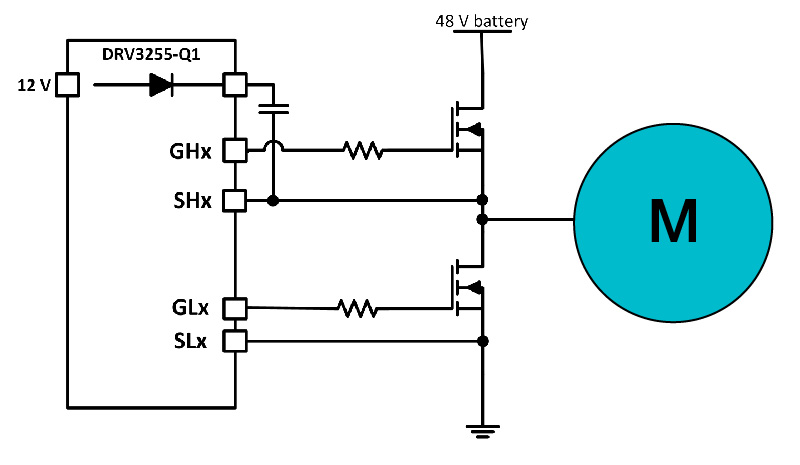Manufacturers build mild hybrid electric vehicles (MHEVs) with the ultimate goal of reducing greenhouse gas (GHG) emissions. An MHEV incorporates a 48-V motor-drive system connected to the transmission system of a vehicle. To reduce GHG emissions, the internal combustion engine (ICE) in an MHEV turns off when the vehicle is coasting, while the 48-V motor system charges the 48-V battery to provide electricity for the vehicle. In this article, I will discuss how to create a 48-V motor-driver design that offers high-power motor driving, achieves functional safety and is small in size.
Considerations in high-power motor driving
A typical 48-V motor-drive system requires 10 kW to 30 kW of electrical power for automotive powertrain applications. The insufficiency of a conventional 12-V battery system for this power level has necessitated the adoption of 48-V architectures to support high-power motor driving.

Solve key motor-drive design challenges

As illustrated in Figure 1, a 48-V motor driver controls external metal-oxide semiconductor field-effect transistors (MOSFETs) in order to spin the motor. These external MOSFETs must support more than 600 A of current to achieve a target of 30 kW. Minimizing the RDS(on) of the MOSFETs will reduce heat dissipation and conduction losses, and in some cases, paralleling multiple MOSFETs per channel will help distribute the heat, as explained in the application note, “Driving Parallel MOSFETs Using the DRV3255-Q1.” The total gate charge of the MOSFETs may be as high as 1,000 nC.
Designers also need to optimize power dissipation caused by switching losses in order for the total solution to meet automotive electromagnetic compliance (EMC) specifications. A high-gate-current gate driver such as the DRV3255-Q1 can drive high-gate-charge MOSFETs with a peak source current of up to 3.5 A and a peak sink current of up to 4.5 A. Such high output currents allow for a short rise and fall time, even with a 1,000-nC gate charge. A selectable gate-driver output current level enables you to fine-tune the rise and fall time, optimizing between switching losses and EMC performance.

Figure 1: The most common power-supply architecture for high-power 48-V motor drivers
Even though the nominal battery voltage is 48 V, the supply voltage can vary significantly because of transient conditions during operation; see the voltage levels specified by International Organization for Standardization (ISO) 21780 in Figure 2. In addition, the motor-driver pins need to survive negative transient voltages given the reverse-recovery time of the parasitic body diodes of the MOSFETs.

Figure 2: Voltage levels for a 48-V system specified in ISO 21780
With a high-side bootstrap pin capable of tolerating 105 V, the DRV3255-Q1 is able to support true continuous operation at 90 V, with transient support up to 95 V. The bootstrap, high-side MOSFET source and low-side MOSFET source are rated for –15-V transients, providing the strong protection that a high-power motor-driver system requires.
Functional safety considerations for 48-V motor drivers
48-V motor-drive systems run the risk of generating unwanted power, which can lead to an overvoltage condition that damages the system. The normal system response is to turn on all high-side or low-side MOSFETs to recirculate the motor current and prevent further power generation. If a fault condition occurs, the system must have a mechanism to switch the functional MOSFETs appropriately to avoid further damage. External logic and comparators are typically necessary to implement this kind of protection.
Active short-circuit logic, which is integrated in the DRV3255-Q1, allows you to decide how to respond when a fault condition is detected. Instead of disabling all MOSFETs in response to a fault condition, this logic is configurable to enable all of the high-side MOSFETs, enable all of the low-side MOSFETs, or dynamically switch between low-side or high-side MOSFETs, depending on the fault condition. In addition, the DRV3255-Q1 is designed for functional safety compliance according to ISO 26262, and incorporates diagnostic and protection features to support functional safety motor-driver system implementations up to Automotive Safety Integrity Level D (ASIL D).
Size considerations for 48-V motor drivers
The limited space in the engine compartment leads to small board-size requirements for 48-V motor-driver systems. Figure 3 shows a typical motor-driver block diagram for a traditional 48-V high-power motor-driver design. Implementing a safe motor-driver system with strong protection requires clamping diodes, external drive circuitry, a sink-path resistor and diodes, comparators, and external safe logic. These external components increase board space and system cost.

Figure 3: Motor-driver block illustration (one phase)
Integrating the external logic and comparators, adjustable high-current gate driver, and support for large voltage transients without requiring additional external components offers a significant advantage to minimize the overall board size with the DRV3255-Q1, as shown in Figure 4.

Figure 4: Simplified DRV3255-Q1 motor-driver block illustration (one phase)
As 48-V MHEVs become more common, are you considering one for your next car?
Additional resources








